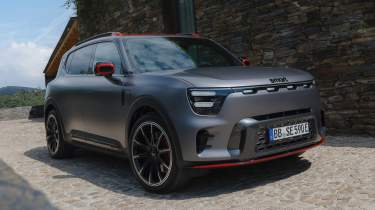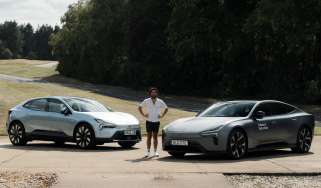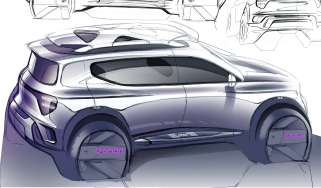Smart #5 review
The Tesla Model Y may need to sleep with one headlight open because of Smart’s audacious, supremely spacious and tech-centric SUV

Our opinion on the Smart #5
The Smart #5 encapsulates the phrase ‘go big or go home’. We were astounded by how well it handles, while still being comfortable, as well as by the vast amount of space inside, some of the technology onboard and the overall quality, especially for the proposed price. All-in-all, it’s a real threat to the Tesla Model Y. However, what’s holding this big, bold SUV back is the woefully inefficient powertrain that resulted in a disappointing real-world range and will make it more expensive to run than rivals.
| Key specs | |
| Fuel type | Electric |
| Body style | Mid-size SUV |
| Powertrain | 76kWh battery, 1x electric motor, rear-wheel drive 100kWh battery, 1x electric motor, rear-wheel drive 100kWh battery, 2x electric motor, all-wheel drive |
| Safety | Not Euro NCAP tested yet |
| Warranty | Three years/unlimited miles |
About the Smart #5
Aside from MINI and maybe Fiat, there are no other car makers more synonymous with compact models than Smart, creators of the ForTwo city car. A lot of people still think that’s all it does, even though the smallest car in its line-up is now a 4.3-metre-long compact SUV called the Smart #1, which about to be dwarfed in showrooms by the even bigger Smart #5.
While the #5 – and yes, you do pronounce the hashtag in the name – is another step away from the company’s origins, it was only a matter of time before Smart launched a mid-size electric SUV given the enormous success of the Tesla Model Y – the world’s best-selling EV – as well as others like the Skoda Enyaq, Hyundai Ioniq 5 and Audi Q4 e-tron.
Used - available now

2026 BMW
2 Series Coupe
40,093 milesAutomaticPetrol2.0L
Cash £26,000
2018 Kia
Stonic
36,313 milesManualPetrol1.0L
Cash £10,697
2019 Vauxhall
Corsa
32,642 milesManualPetrol1.4L
Cash £7,997
2022 Volvo
XC60
33,654 milesAutomaticPetrol2.0L
Cash £31,897We’ve been told the Smart #5 will go on sale in the UK towards the end of the year, and there will be no fewer than six different variants to choose from: Pro, Pro+, Premium, Pulse, Summit Edition and Brabus. You’ll get what you’re given with each one, with no option packs or different powertrains to confuse matters. Customers simply select the model they want, plus the paint and interior colour scheme.
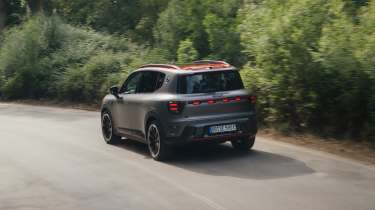
Pricing won’t be confirmed for a little while yet, but we’re told we can expect the range to kick off from close to £40,000 and range-topping versions will cost less than £55,000. Coincidentally, the Model Y is currently priced from about £45k-£52k, but the #5 may also be within spitting distance of the Enyaq and Ioniq 5, which both start from £39k.
Every Smart #5 is set to feature a 10.25-inch digital driver’s display, a 13-inch central touchscreen, wireless Apple CarPlay and Android Auto, a panoramic sunroof, wireless charging pad, keyless entry and lots of driver-assistance technology such as adaptive cruise control, blind-spot detection and traffic-sign recognition.
Higher-spec versions add even more impressive tech, including a 26-inch augmented-reality head-up display, a 20-speaker Sennheiser stereo, matrix LED headlights, an energy-saving heat pump and another 13-inch display for the front passenger to stream movies, play games or fiddle with various settings on while being chauffeured around.
The range-topping Smart #5 Brabus also features 21-inch monoblock wheels, lots of red accents both inside and out, red brake calipers and upgraded seats with Alcantara upholstery. Plus a 637bhp dual-motor drivetrain, meaning it’s very nearly as powerful as the sensational Hyundai Ioniq 5 N.
The entry-level Pro model uses a chunky 76kWh (74.4kWh usable) battery that's good for up to 289 miles on single charge, according to Smart, while other variants pack a gigantic 100kWh (94kWh usable) battery that ups the official range to 366 miles, or 335 miles in the Brabus.
Performance & driving experience
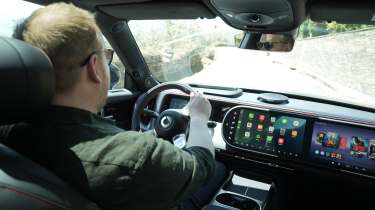
| Pros |
|
| Cons |
|
Normally, when we drive a brand-new car for the first time, we’re given whichever model is expected to be the most popular, and maybe the base version, before later being allowed to try the fast one. This time however, we received the full monty right away and were handed the keys to the power-mad Smart #5 Brabus that’ll make up a relatively small portion of this car’s total sales.
But while it’s nearly as powerful as the sensational Hyundai Ioniq 5 N, the Brabus version doesn’t get any suspension, brake or chassis upgrades over a regular #5 with the big battery. On the one hand, it means we don’t have to wait to drive other variants to know how well the new Smart handles, but shoving huge power into a big, heavy car is the same recipe American muscle cars used in the sixties and seventies.
So we weren’t brimming with confidence when we fired up the #5 Brabus, and prepared to hear the sound of the door handles scraping along the tarmac. But this didn’t happen. In fact, we struggled to detect any body roll through the corners. The brakes are strong too, and the steering is well weighted. There was some faint screeching from the tyres, but nowhere nearer as bad as we found it in the Skoda Enyaq recently.
Not only does the #5 handle well, the ride is comfortable and the suspension does an excellent job of absorbing the impacts from potholes and the like. It can occasionally become unsettled after over imperfections on the motorway, but otherwise the car feels stable cruising along, and is very quiet inside. The only slight intrusion is some whistling coming from around the base of the windscreen.
Ironically for a Smart car, the #5 feels a little out of its depth in town. Its size and the way the bonnet is shaped make it hard to tell how close you are to the kerb. There is an ‘S-pedal’ function for one-pedal driving, which is useful, but there’s also a delay between you lifting off the accelerator and the car starting to slow. This occurs no matter which setting the regenerative braking is in, and stopping and starting for junctions feels quite jerky.
For those models fitted with the passenger screen, Smart promises the #5 will detect if the driver tries to sneak a peek at whatever's playing on the display, and will turn it off to ensure you focus on the road. However the system didn’t interject once when we tried to provoke it. We were warned the car’s software is still being fine-tuned, and hopefully this function will have been improved by the time deliveries begin.
Performance, 0-60mph acceleration and top speed
The Smart #5 will be available with a single-motor, rear-wheel-drive set-up, or dual-motors for all-wheel drive. Power outputs range from 335bhp to 579bhp. The brand claims even the base car will do 0-62mph in less than seven seconds, while regular dual-motor cars can do the same sprint in 4.9 seconds. The standard selection of Eco, Comfort and Sport modes is available in all of them, but all-wheel-drive models also come with special Sand, Snow, Mud and Rock drive modes, plus an Adaptive setting that’s designed to let you adjust the car’s various parameters on the fly.
Meanwhile the Brabus edition we drove features an uprated dual-motor powertrain that produces a combined 637bhp and 710Nm of torque, and makes this 2.4-tonne family SUV an absolute rocketship, capable of 0-62mph in a frankly ridiculous 3.8 seconds. Top speed is limited to 130mph.
Activate Brabus mode and once there’s there’s enough empty, open road in front of you, flooring the hyperspeed button that’s disguised as the accelerator pedal shoves you back in your seat as the muscles in your cheeks start to tense, while trees, cyclists and counties become a blur as they fly past.
As in the Ioniq 5 N, drivers can add a synthesised soundtrack to make the driving experience more engaging in the #5 Brabus. ‘Swift’ is the only one we’d recommend because it emits a Star Trek-esque note, while the others make it sound like you’re driving a Dyson vacuum.
Switch to Comfort mode and acceleration is much more gradual and less eye-widening, but of course you’ve still got all that power, so accelerating to motorway speeds and overtaking is truly effortless.
| Model | Power | 0-62mph | Top speed |
| Pro | 335bhp | 6.9s | 124mph |
| Premium | 358bhp | 6.5s | 124mph |
| Pulse | 579bhp | 4.9s | 124mph |
| Brabus | 637bhp | 3.8s | 130mph |
Expert view, on driving experience
“We were amazed by how comfortable the ride is in the Smart #5 Brabus, with its 21-inch monoblock wheels, so hopefully it will be even better on models sporting 19-inch rims.” - Ellis Hyde, news reporter, who drove the car on the international press launch in Porto, Portugal.
Range, charging & running costs
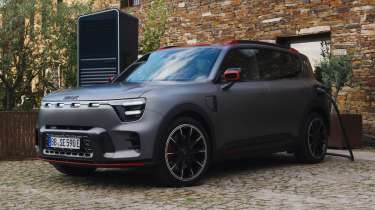
| Pros |
|
| Cons |
|
The Smart #5 doesn’t boast the most impressive range figures we’ve seen from an electric SUV, but worse still is that its key rivals can all cover about the same distance or further using smaller batteries. So you might assume that Smart’s figures are simply more realistic, and actually achievable in the real world. But no.
We covered more than 150 miles in the #5 Brabus in hot and sunny Portugal, which included a mixture of town, back-road and motorway driving, and averaged an alarming 2.4 miles per kWh. For context, when we tested the new Model Y recently in the UK, it did 3.9 miles/kWh. What this means is, based on the Smart battery’s usable capacity, you could cover just 225 miles before running out of juice. That’s barely enough to get from London to Manchester, and less range than you get in the pocket-sized Hyundai Inster, proving it’s not the size of the battery that matters, it’s what you do with it.
To counteract the energy-devouring powertrain, the #5 is able to charge quicker than almost anything else on the road right now, with Smart claiming it can reach a lightning-fast 400kW. Admittedly, there are no charging points capable of that speed in the UK yet, but even using the 350kW units found in most motorway service stations, topping up that massive 100kWh battery from 10-80% should take just 18 minutes, in optimal conditions.
The #5 can charge at those ridiculous speeds thanks to a cutting-edge 800-volt architecture, like you’ll find in the Hyundai Ioniq 5 or the Porsche Taycan. However, note that the Pro model uses a slower 400-volt system that allows for a maximum charging speed of 150kW instead, so even with the smaller battery, a 10-80% top-up takes closer to 30 minutes.
Smart says the #5 will also offer Vehicle to Load (V2L) and ‘Plug and Charge’ capabilities – the latter enabling automatic authentication and payment between the vehicle and certain charging stations.
| Model | Battery size | Range |
| Pro | 76kWh | 289 miles |
| Premium | 100kWh | 366 miles |
| SPulse | 100kWh | 335 miles |
| Brabus | 100kWh | 335 miles |
Tax
From April 1 2025, electric cars attract the same £195 annual rate of Vehicle Excise Duty (VED) or ‘road tax’ as any other cars on the road. They’re also subject to the £425 expensive vehicle supplement for any models with a list price of more than £40,000 when new, which we’re assuming will apply to every version of the Smart #5. The Benefit-in-Kind (BiK) company car tax rate for EVs is three per cent for the 2025/26 tax year.
Interior, design & technology

| Pros |
|
| Cons |
|
The #5 represents a new design direction for the brand, separating itself from the curvaceous Smart #1 and #3 with a boxy design has a touch of the Land Rover Defender and Mercedes G-Class about it. That’s what’s hot right now, and the brand wants people to know this is its car for people who want to explore beyond the city limits.
Other unique styling features include the segmented light bars at the front and rear, the large oblong headlight units, and pronounced rear wheelarches that give the #5 a planted and rather muscular stance for an SUV. However the smooth surfacing is a familiar Smart car design trait. Wheel sizes run from 19 to 21 inches.
Interior and dashboard design
The interior layout in the Smart #5 features so many screens it can feel like you’re in Piccadilly Circus. We’ll talk more about those in a bit, but it’s worth noting that the dashboard design is the same for every model; there’s just a dot-matrix-style pattern in place of the passenger screen in those models that do without it. The choice of trim level also affects the different materials inside, with the Brabus model we tested featuring plenty of Alcantara on the steering wheel, seats and centre console.
Materials and build quality
The cabin is another area where the #5 elevates itself above its smaller siblings. The perceived quality takes a welcome jump in the right direction, with soft-touch materials everywhere, and even the plastic surfaces and switchgear have a pleasing, smooth finish. Overall, the cabin feels solid and well built.
Sat-nav, stereo and infotainment
All the screens in the #5 are sharp, and the infotainment system is snappy with menus and graphics loading quickly. It includes a drop-down control centre like a smartphone’s, with numerous shortcut buttons, plus more across the bottom of the touchscreen, to help make up for the lack of physical buttons in the cabin – and the endless, somewhat overwhelming number of menus for the car’s settings.
Wireless Apple CarPlay and Android Auto come as standard, while the 1,190-watt, 20-speaker Sennheiser sound system (with Dolby Atmos in higher-spec models) is exceptionally clear and very powerful.
Every Smart model features an animal avatar for the virtual assistant, and for the #5 it’s Leo the lion that sits at the base of the touchscreen and is rendered in real-time but doesn’t actually do anything. Meanwhile maps and other functions can be sent over to the instrument cluster by swiping left or right with three fingers.
“To my eyes, the Smart #5 is a very handsome and muscular SUV, however some may find the design a big jarry. Either way, it certainly stands out from the litany of other SUVs on the market.” - Ellis Hyde, news reporter, who drove the car on the international press launch in Porto, Portugal.
Boot space & practicality

| Pros |
|
| Cons |
|
Smart has always worked to create the most interior space possible, relative to its cars’ footprint on the road, which it calls the ‘Body Size Index’. Apply that philosophy to a mid-size SUV rather than an ultra-compact runabout, and – unsurprisingly – the #5 is supremely spacious in the front and the back. Six-foot-tall adults can stretch out like they’re in business class, and have headroom to spare, even with the enormous, single-piece panoramic sunroof that makes the cabin feel even more spacious and airy.
Behind the rear seats there’s a huge 630-litre boot, which trumps the Skoda Enyaq’s 585 litres. The luggage capacity expands to 1,530 litres with the 60:40 split-fold bench folded flat. Unlike some other electric SUVs, the #5 has a ‘frunk’ under the bonnet that offers up to 72 litres of extra storage if you go for a rear-wheel drive model. Opt for one with all-wheel drive and the space shrinks to 47 litres, but that’s still a whole lot better than rivals that don't offer any extra space.
Smart offers a “one-button comfort mode” – colloquially referred to as “king mode” or “boss mode” by its developers – which folds everything flat. Smart’s designers say they’re working on a solution to turn the car into a makeshift camper, with a removable mattress or bed that can be placed in the rear. Dual-motor cars also have a 1,600kg towing capacity.
| Dimensions | |
| Length | 4,705mm |
| Width | 1,920mm |
| Height | 1,705mm |
| Number of seats | 5 |
| Boot space | 630-1,530 litres |
Reliability & safety

| Pros |
|
| Cons |
|
The Smart #5 hasn’t received a crash-safety rating from Euro NCAP yet, although the fact the #1 and #3 both received the maximum five stars when they were tested is a good indication of how their big brother will do. On top of that, every Smart #5 will come loaded with safety kit, including a host of airbags, and advanced driver-assistance systems (ADAS), including adaptive cruise control with stop & go function and highway driving assist. These features have been tested and honed on UK roads, apparently.
Of course, a lot of people want to turn off their cars’ driver-assistance tech, and this is relatively simple process in the #5. Much like in the Renault Scenic, drivers can set up a unique profile with their preferred settings for the ADAS suite, and activate it quickly using the customisable button on the steering wheel and confirming it on the touchscreen.
Smart Europe CEO Dirk Adelmann said he’s looking to implement over-the-air (OTA) updates in time that will allow owners to save their preferences for things such as lane-keep assist and speed-limit warnings – letting them activate or deactivate certain settings in bulk.
| Key standard safety features |
|
Buying and owning
Our best buy: Smart #5 Premium
The mid-range Smart #5 Premium is likely to be our pick of the range when order books open later this year. For starters, it comes with the bigger battery pack for up to 366 miles of range and a single rear-mounted electric motor producing an ample 358bhp. It also has some of the more impressive kit, including the 20-speaker Sennheiser stereo and augmented-reality head-up display, but does without the separate passenger display, which we think is pretty pointless.
Smart #5 alternatives
The Smart #5 is a mid-size electric SUV, which means it competes primarily against the Tesla Model Y, which was again the world’s best-selling EV last year, and has just received a series of major updates. Of course, that’s not the only fish in this particular pond. Other electric family SUVs include the Skoda Enyaq, Hyundai Ioniq 5 and Renault Scenic, plus there’s the Audi Q4 e-tron and the new BMW iX3 coming soon for those looking at the more premium end of the segment.
Frequently Asked Questions
The Smart #5 is comfortable, incredibly spacious and packed with technology, plus it handles remarkably well for a big family SUV.

